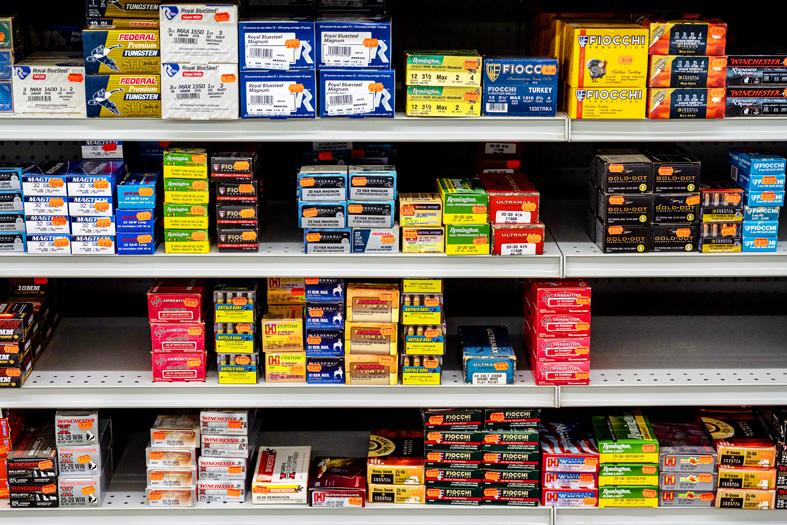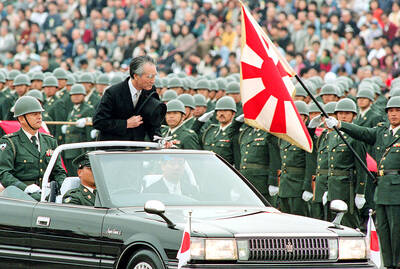The COVID-19 pandemic, coupled with record sales of firearms, has fueled a shortage of ammunition in the US that is affecting law enforcement agencies, people seeking personal protection, recreational shooters and hunters — and could deny new gun owners the practice they need to handle their weapons safely.
Manufacturers say they are producing as much ammunition as they can, but many gun store shelves are empty and prices keep rising. Ammunition imports are way up, but at least one US manufacturer is exporting ammo. All while the pandemic, social unrest and a rise in violent crime have prompted millions to buy guns for protection or to take up shooting for sport.
“We have had a number of firearms instructors cancel their registration to our courses because their agency was short on ammo or they were unable to find ammo to purchase,” National Law Enforcement Firearms Instructors Association executive director Jason Wuestenberg said.

Photo: Bloomberg
Doug Tangen, firearms instructor at the Washington State Criminal Justice Training Commission, the police academy for the state, said the academy also has had trouble obtaining ammo.
“A few months ago, we were at a point where our shelves were nearly empty of 9mm ammunition,” he said.
In response, instructors took conservation steps like reducing the number of shots fired per drill, which got them through several months until fresh supplies arrived, Tangen said.
Officer Larry Hadfield, a spokesman for the Las Vegas Metropolitan Police Department, said his department also has been affected by the shortage.
“We have made efforts to conserve ammunition when possible,” he said.
The National Shooting Sports Foundation, an industry trade group, has said that more than 50 million people participate in shooting sports in the US and estimated that 20 million guns were sold last year, with 8 million of those sales made by first-time buyers.
“When you talk about all these people buying guns, it really has an impact on people buying ammunition,” foundation spokesman Mark Oliva said. “If you look at 8.4 million gun buyers and they all want to buy one box with 50 rounds, that’s going to be 420 million rounds.”
The FBI’s National Instant Criminal Background Check System database also documented an increase in sales: In 2010, there were 14.4 million background checks for gun purchases. That jumped to almost 39.7 million last year and to 22.2 million just through June this year alone.
The actual number of guns sold could be much higher, as multiple firearms can be linked to a single background check. No data is available for ammunition, because sales are not regulated and no license is required to sell it.
As the pandemic raced across the US early last year, the resulting lockdown orders and cutbacks on police response sowed safety fears, creating an “overwhelming demand” for guns and ammo, Oliva said.
Factories continued to produce ammunition, but sales far exceeded the amount that could be shipped, he said.
“Where there is an increased sense of instability, fear and insecurity, more people will purchase guns,” said Ari Freilich of the Gifford Law Center to Prevent Gun Violence.
As supplies dwindled, some gun owners began stockpiling ammo, Feilich said.
“Early on in the pandemic, we saw people hoarding toilet paper, disinfectant and now it’s ammo,” he said.
Wuestenberg emphasized the danger in first-time gun buyers not being able to practice using their new weapons.
Going to the gun range entails more than trying to hit a target, he said.
It is where shooters learn fundamental skills like always pointing their guns in a safe direction and keeping their fingers off the trigger until they are ready to fire.
“It’s that old adage: Just because you buy a guitar doesn’t mean you’re a guitar player,” Wuestenberg said. “Some have the misconception of ‘I shot this target five yards away and did just fine so I’m OK if someone breaks into my house.’ You’ve got to go out and practice with it.”
The US military is not affected by the shortage, because the US Army produces ammunition for all branches of the military at six sites across the country, US Army Joint Munitions Command spokesperson Justine Barati said.
The US shooting team, which won four medals at the Tokyo Olympics, also had the ammo needed to train thanks to a commitment from sponsors, but membership and junior programs have struggled, said Matt Suggs, chief executive officer for USA Shooting.
The US Biathlon team, training for the 2022 Winter Olympics in February, also has been supplied with ammo from its sponsor, Lapua, made in Finland.
However, local clubs face shortages, said Max Cobb, president of US Biathlon Association.
Jason Vanderbrink, a vice president at Vista Outdoor, which owns the Federal, CCI, Speer and Remington ammunition brands, said the companies are shipping ammo as fast as they can make it.
Imports of ammunition from Russia, South Korea, the EU and others were up 225 percent over the past two years, according to an analysis by Panjiva Inc, which independently tracks global trade.
However, at least some US-made ammo is heading out of the country.
Winchester has logged 107 shipments since January last year, according to Panjiva. Most went to Australia to fulfill a contract Winchester secured with NIOA, the country’s largest small-arms supplier.

The Venezuelan government on Monday said that it would close its embassies in Norway and Australia, and open new ones in Burkina Faso and Zimbabwe in a restructuring of its foreign service, after weeks of growing tensions with the US. The closures are part of the “strategic reassignation of resources,” Venezueland President Nicolas Maduro’s government said in a statement, adding that consular services to Venezuelans in Norway and Australia would be provided by diplomatic missions, with details to be shared in the coming days. The Norwegian Ministry of Foreign Affairs said that it had received notice of the embassy closure, but no

A missing fingertip offers a clue to Mako Nishimura’s criminal past as one of Japan’s few female yakuza, but after clawing her way out of the underworld, she now spends her days helping other retired gangsters reintegrate into society. The multibillion-dollar yakuza organized crime network has long ruled over Japan’s drug rings, illicit gambling dens and sex trade. In the past few years, the empire has started to crumble as members have dwindled and laws targeting mafia are tightened. An intensifying police crackdown has shrunk yakuza forces nationwide, with their numbers dipping below 20,000 last year for the first time since records

EXTRADITION FEARS: The legislative changes come five years after a treaty was suspended in response to the territory’s crackdown on democracy advocates Exiled Hong Kong dissidents said they fear UK government plans to restart some extraditions with the territory could put them in greater danger, adding that Hong Kong authorities would use any pretext to pursue them. An amendment to UK extradition laws was passed on Tuesday. It came more than five years after the UK and several other countries suspended extradition treaties with Hong Kong in response to a government crackdown on the democracy movement and its imposition of a National Security Law. The British Home Office said that the suspension of the treaty made all extraditions with Hong Kong impossible “even if

Former Japanese prime minister Tomiichi Murayama, best known for making a statement apologizing over World War II, died yesterday aged 101, officials said. Murayama in 1995 expressed “deep remorse” over the country’s atrocities in Asia. The statement became a benchmark for Tokyo’s subsequent apologies over World War II. “Tomiichi Murayama, the father of Japanese politics, passed away today at 11:28am at a hospital in Oita City at the age of 101,” Social Democratic Party Chairwoman Mizuho Fukushima said. Party Secretary-General Hiroyuki Takano said he had been informed that the former prime minister died of old age. In the landmark statement in August 1995, Murayama said